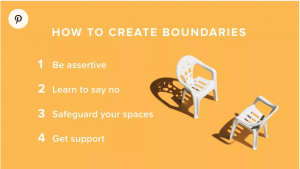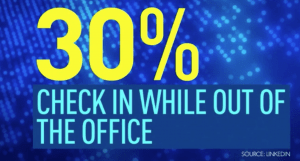Welcome back to another installment of our Wellness Wednesday’s series! Over the past couple weeks we have been facilitating bite sized webinars covering different wellness topics.This week we will be covering creating healthy boundaries and what that looks like between different spaces such as relationships, careers, and personal boundaries.
Establishing boundaries is a fundamental part of forming one’s identity and is a significant component of mental health and well-being. Boundaries, as we will discuss can be physical, emotional, and even digital. They can range from being loose to rigid, with healthy boundaries often falling somewhere in between. Our first step to is understand what boundaries exactly are.
Generally speaking, “Healthy boundaries are those boundaries that are set to make sure mentally and emotionally you are stable” (Prism Health North Texas, n.d.). It a tool that helps us communicate to others that we have self-respect, self-worth, and will not allow others to define our own-self. Healthy boundaries allow us to separate who we are, and what we think and feel, from the thoughts and feelings of others. Their presence helps us express ourselves as the unique individuals we are, while we acknowledge the same in others. Our boundaries can be influenced by a number of things that make us who we are.
Our boundaries are shaped by
- our heritage or culture
- the region we live in or come from
- whether we’re introverted, extroverted, or somewhere in between
- our life experiences
- our family dynamics
(Healthline, 2020)
It is important to recognize that we all come from unique family experiences and different cultural that hold different values. This is why we find different meanings to situations that we may encounter. Our boundaries could change as our perspective shifts through the years. That is why there is not one stand alone standard for what our healthy boundaries should look like. Instead, each individual should explore what makes them feel comfortable within the context of who they are.
We can set boundaries for our
- personal space
- sexuality
- emotions and thoughts
- stuff or possessions
- time and energy
- culture, religion, and ethics
(Healthline, 2020)
Boundaries offer us a sense of ownership over our physical environment, body, and sentiments. All of us carry thresholds when it comes to many things and boundaries communicates those limits.
Now let us continue to elaborate on why we need to establish healthy boundaries and their benefits!
-
Boundaries improve our relationships and self-esteem
Establishing healthy boundaries in a relationship allows both partners to feel comfortable and develop positive self-esteem. Boundaries safeguard relationships from becoming unsafe. A lot of times, we tend to focus on adjusting to others, taking time away from focusing on ourselves. Setting boundaries for yourself that reflect who you are and who you ultimately want to be will only enhance setting boundaries with your partner in a relationship. With that in consideration, they in fact bring us closer together than farther apart, and are therefore necessary in any relationship.
-
Boundaries allow us to conserve our emotional energy and focus on self-care
Healthy boundaries are a crucial component of self-care. Your self-esteem and identity can be impacted, and you can build resentment toward others because of an inability to advocate for yourself. Boundaries that let us have different responses depending on the situation or person can also help you maintain enough energy to care for yourself. Setting healthy boundaries can have many benefits, including helping people make decisions based on what is best them, not just the people around them. This autonomy is an important part of self-care.
-
Boundaries give us space to grow and be vulnerable
During times like these we all have complex feelings to a lot of whats going on. In setting boundaries and then breaking them, when the time is right, you’re showing your vulnerability. This could be as simple as talking openly to friends and family. When we display our vulnerability to someone, we let them know that they’re welcome to open up to us sometime when they need to. This nurtures a space to grow together and learn more about what our boundaries are in many different spaces.
Some all this talk about boundaries may leave you with the question of how do I create them in my personal, professional and digital spaces. Here are some steps to take that will help in creating these healthy boundaries:
(Healthline, 2020)
1. Be assertive
Assertiveness in creating boundaries is facilitated in being solidified but warm to others. Assertive language is clear and nonnegotiable, without criticizing or intimidating the recipient. You can be assertive by using “I statements.” I statements demonstrate confidence and good boundary setting by expressing thoughts, feelings, and opinions without worrying what others are thinking.
HOW TO USE I STATEMENTS
I feel ____ when _____ because ____________________________.
What I need is ______________________________________________.
| Effective communication | Ineffective communication |
| I feel violated when you read my journal because I value privacy. What I need is a space that I know is private to record my thoughts. | Keep your hands off my journal! |
| I feel overwhelmed when every minute of our vacation is planned. What I need is some time just to relax and see what happens. | You’re making this vacation exhausting, and I don’t want to do all the things you’ve planned. |
2. Learn to say no
This can be very difficult but some of us but it is important to know that “NO” is a complete sentence! You can say no without an explanation and without providing any emotional labor to the person you’re saying it to. If someone asks for your number or to dance, you can absolutely just say no. If a co-worker asks you to cover their shift, you can also say no, without offering any excuse.
3. Safeguard your spaces
You can also set boundaries for your stuff, physical and emotional spaces, and your time and energy without necessarily announcing it, too. The features on your tech devices offer some ways of doing this.
Savvy Boundary safeguards
- Put private items in a locked drawer or box.
- Schedule nonnegotiable alone time or time when you’re just doing your own thing.
- Set a cut-off time for answering emails or texts.
- Temporarily delete email and messaging apps when you don’t want to be contacted.
- Use the Do Not Disturb feature on your phone and other devices.
Finally, this provides a perfect transition to the final boundary we’d like to cover that we carry everywhere we go. Digital boundaries intersect in a number of different spaces. It can be hard to know where the line between healthy and unhealthy is once a relationship goes online. What are the rules for Facebook, Instagram, Twitter, Tumblr, Snapchat? What should your digital relationship look like? Before you talk to your partner about your online relationship, check in with yourself to see what makes you feel comfortable. Start by considering your digital boundaries:
- Is it okay to tag or check in?
- Do we post our relationship status?
- Is it okay to friend or follow my friends?
- When is it okay to text me and what is the expectation for when we return it?
- Is it okay to use each other’s devices?
- Is it okay to post, tweet or comment about our relationship?
Conversely, we often encounter issues in establishing digital boundaries when it comes to our professional life. It is important to create professional safeguards so that we are taking care of ourselves and not overextending ourselves. If we fail to do this we run the risk of burnout and continued unhealthy habits. Here are some tips to create some healthy digital boundaries as it pertains to work:
Digital Boundary Safeguards
- Set a cut-off time for answering emails or texts.
- Use the “out of office” responder on email accounts when on vacation.
- Set “after-office hours” ex. “7pm-9am I will not be taking work request”
- Send verification of your time off days in advance.
- Temporarily delete email and messaging apps when you don’t want to be contacted.
- Use the Do Not Disturb feature on your phone and other devices.
- Make a promise to yourself not to respond to work messages or calls sent to personal accounts
- Ask yourself “Can this wait”. Communicate that you will answer later
Take Home Message:
Boundaries are all about respect and are a great way to make sure that each others needs are being met and that you feel safe in your relationship, career, and digitally!




